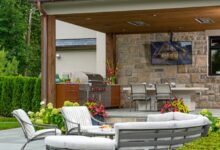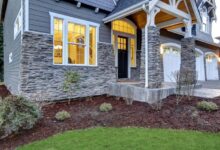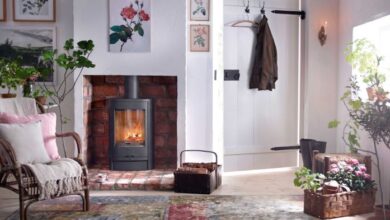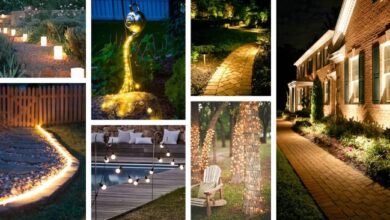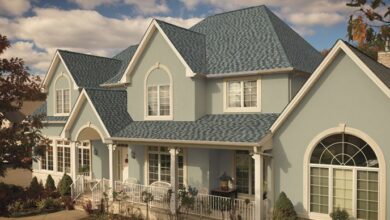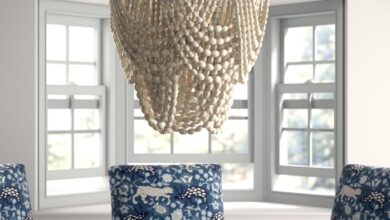Home exterior landscaping ideas for curb appeal
Home exterior landscaping ideas offer a transformative approach to enhancing your property’s aesthetic value and curb appeal. From budget-friendly DIY projects to sophisticated designs incorporating sustainable practices and outdoor lighting, the possibilities are vast. This exploration delves into diverse landscaping styles suited to various home architectures, emphasizing the importance of thoughtful plant selection, material choices, and the integration of hardscaping elements to create a harmonious and functional outdoor space.
We’ll examine how to maximize curb appeal, create relaxing backyard oases, and implement eco-friendly solutions for a landscape that’s both beautiful and environmentally conscious.
We will cover a range of topics, from designing cost-effective landscaping plans for different home styles to creating visually stunning front yards and tranquil backyards. We’ll also explore the use of sustainable materials and practices, efficient irrigation techniques, and the strategic placement of outdoor lighting to enhance both beauty and security. The goal is to provide a comprehensive guide that empowers you to design and create an outdoor space that reflects your personal style and enhances your home’s overall value.
Budget-Friendly Landscaping Ideas
Transforming your home’s exterior doesn’t require a fortune. With careful planning and a little creativity, you can achieve a stunning landscape on a modest budget. This section explores three distinct landscaping styles – modern, traditional, and rustic – each achievable with cost-effective materials and techniques. We’ll also delve into the simple process of creating a DIY rock garden and offer innovative ways to repurpose everyday items into unique landscaping features.
Three Budget-Friendly Landscaping Plans
Creating a beautiful landscape on a tight budget is entirely possible. The key is to choose materials wisely and focus on a cohesive design. Below are three distinct landscaping plans, each highlighting a different style and emphasizing affordability. Estimated costs are approximate and may vary based on location and material availability.
| Style | Description | Material List | Estimated Cost |
|---|---|---|---|
| Modern | Clean lines, minimalist planting, and the use of gravel or concrete. Emphasizes geometric shapes and functionality. | Gravel (1 cubic yard), concrete pavers (20 sq ft), drought-tolerant plants (5), simple modern planters (2), metal edging (10 ft). | $300 – $500 |
| Traditional | Classic design featuring flowering plants, neatly trimmed hedges, and a well-maintained lawn. Focuses on symmetry and established landscaping elements. | Seed for lawn (1 lb), flowering annuals (10), shrubs (3), mulch (2 cubic yards), garden tools (shovel, rake, hoe). | $200 – $400 |
| Rustic | Natural, informal look using natural materials like wood, stone, and native plants. Emphasizes texture and a relaxed, informal aesthetic. | Untreated lumber (for edging or pathways), river rocks (1 cubic yard), native wildflowers (10), reclaimed wood planters (2), compost. | $250 – $450 |
Creating a DIY Rock Garden
A rock garden offers a low-maintenance, visually appealing addition to any landscape. It requires minimal upkeep and can thrive even in challenging conditions. Here’s a step-by-step guide:
- Site Selection: Choose a sunny location with good drainage. Rock gardens generally need at least six hours of sunlight per day.
- Material Selection: Select a variety of rocks and stones in different sizes, shapes, and colors. Consider using locally sourced materials for a more natural look and to reduce transportation costs. Avoid using sharp or angular rocks that could be hazardous.
- Placement: Start by placing the largest rocks first, creating a natural-looking base. Arrange smaller rocks and stones around the larger ones, filling in gaps and creating texture. Avoid symmetrical arrangements for a more organic feel.
- Plant Selection: Choose drought-tolerant plants that thrive in well-drained soil, such as sedums, succulents, and alpine plants. Consider the mature size of the plants to ensure they don’t overwhelm the rock garden.
- Soil Preparation: Prepare the soil by removing weeds and loosening the soil. Amend the soil with compost or other organic matter to improve drainage and fertility. Plant the selected plants, ensuring adequate spacing for growth.
Repurposing Old Materials for Landscaping
Giving new life to old materials is a fantastic way to add character to your landscape while saving money. Here are five creative ideas:
- Pallets: Create vertical gardens or raised garden beds by attaching pallets to a wall or standing them upright. Paint or stain them for a polished look.
- Tires: Transform old tires into unique planters by painting them and filling them with soil. Stack them to create tiered planters or arrange them in interesting patterns.
- Broken Pottery: Use broken pieces of pottery as decorative edging for flowerbeds or pathways. The variety of colors and textures can add visual interest.
- Old Bottles: Create a whimsical mosaic pathway by embedding colorful glass bottles into concrete. This adds a touch of artistry and whimsy to the landscape.
- Reclaimed Wood: Use reclaimed wood to create fences, edging, or pathways. The weathered look adds a rustic charm and complements many landscaping styles.
Landscaping for Different Home Styles
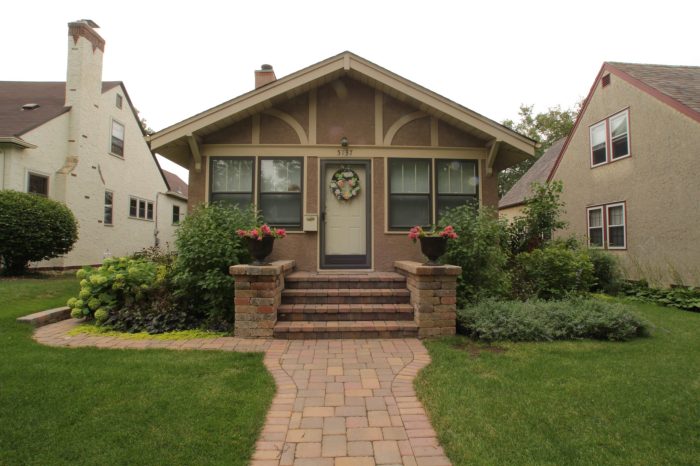
Source: groundonemn.com
Landscaping plays a crucial role in enhancing the curb appeal and overall aesthetic of a home. The style of landscaping should complement the architectural style of the house, creating a cohesive and visually pleasing effect. Different architectural styles lend themselves to different landscaping approaches, requiring careful consideration of plant choices, materials, and overall design.
Landscaping Styles for Victorian, Ranch, and Cape Cod Homes
The following table compares and contrasts landscaping styles suitable for three distinct architectural styles: Victorian, Ranch, and Cape Cod. Careful selection of plants, materials, and design elements ensures the landscaping enhances, rather than clashes with, the home’s architectural features.
Enhancing your home’s curb appeal begins with thoughtful exterior landscaping ideas, considering factors like plant choices and hardscaping. This extends to your porch, which is a prime area for seasonal displays; for a spooky autumn touch, consider checking out some fantastic Halloween porch decorating ideas to complement your overall landscaping scheme. Ultimately, a cohesive design, from the garden beds to the porch, creates a welcoming and visually appealing exterior.
| Home Style | Plant Suggestions | Material Choices | Key Features |
|---|---|---|---|
| Victorian | Ornate flowering shrubs (roses, hydrangeas), climbing vines (ivy, clematis), densely planted flowerbeds, symmetrical arrangements. | Ornate wrought iron fencing, stone pathways, intricate brickwork, fountains, gazebos. | Formal, symmetrical design; emphasis on lush plantings and intricate details; creates a sense of grandeur. |
| Ranch | Native grasses, drought-tolerant shrubs and groundcovers, low-maintenance plants, informal groupings. | Natural stone, gravel, wood, simple fences, patios made of concrete or flagstone. | Informal, relaxed design; emphasizes natural textures and low-maintenance plantings; blends seamlessly with the surrounding landscape. |
| Cape Cod | Low-growing shrubs, perennials, flowering vines, informal arrangements. | Natural stone, weathered wood, white picket fences, simple walkways. | Simple, understated design; creates a sense of warmth and coziness; emphasizes natural materials and textures. |
Mediterranean Landscaping
Mediterranean-style homes, characterized by stucco walls, terracotta roofs, and arched doorways, benefit from landscaping that evokes the sun-drenched landscapes of the Mediterranean region. Plant choices should reflect the region’s climate and aesthetic, emphasizing drought-tolerant plants and a palette of warm colors. Materials such as terracotta, stone, and stucco should be incorporated to create a cohesive design. Examples of suitable plants include olive trees, bougainvillea, lavender, rosemary, and cypress trees.
Creating a stunning home exterior involves careful consideration of landscaping; the right plants and hardscaping can dramatically enhance curb appeal. This careful attention to detail extends indoors too, especially when considering the overall aesthetic; for instance, the interior design might be complemented by investing in pieces from High-end furniture collections. Ultimately, a cohesive design language, both inside and outside, elevates the entire property.
The use of fountains or water features can also add to the overall atmosphere. The focus should be on creating a relaxed, inviting atmosphere that complements the home’s architectural features.
Foundation and Surroundings Considerations in Landscaping Design
Considering the home’s foundation and surroundings is paramount in landscaping design. The foundation’s materials and style should be taken into account when choosing landscaping elements. For instance, a stone foundation might pair well with a rock garden or a natural stone pathway. The slope of the land, existing trees, and proximity to the street also influence design decisions.
Poorly planned landscaping can lead to drainage problems, foundation damage, or an overall disharmonious look. Careful consideration of these factors ensures that the landscaping complements the home’s architecture and protects its foundation. For example, planting trees too close to the foundation can damage the structure through root growth. Similarly, improper drainage can lead to water accumulating around the foundation, potentially causing damage over time.
Therefore, understanding the home’s site conditions is crucial for effective landscaping design.
Creating Curb Appeal with Landscaping
Curb appeal, the visual attractiveness of a property from the street, significantly impacts its value and overall impression. A well-designed landscape is a key component in maximizing this appeal, transforming a house into a welcoming home. Strategic placement of plants, thoughtful hardscaping, and effective lighting work together to create a cohesive and inviting front yard.
Designing a Front Yard Landscape for Maximum Curb Appeal
A successful front yard design begins with a clear focal point. This could be a striking tree, an attractive porch, or a beautifully designed garden bed. Pathways should lead naturally to this focal point, guiding the eye and inviting exploration. Consider using varying materials for pathways – perhaps flagstone for a rustic look or pavers for a more modern feel.
Lighting plays a crucial role in highlighting these focal points and creating ambiance. Low-voltage landscape lighting can subtly illuminate plants, pathways, and architectural features, extending the enjoyment of the landscape into the evening. Plant choices should consider the size and style of the home, the amount of sunlight received, and the overall desired aesthetic. For example, a cottage-style home might benefit from a mix of colorful perennials and flowering shrubs, while a modern home might prefer a more minimalist design with structured evergreens and grasses.
Imagine a front yard with a majestic oak tree as the focal point, its branches elegantly lit at night. A winding flagstone pathway leads from the street to a charming porch, flanked by vibrant hydrangeas and low-growing boxwoods.
Utilizing Color Theory in Landscape Design, Home exterior landscaping ideas
Color theory is essential for creating a harmonious and visually appealing landscape. Consider the color wheel and its complementary, analogous, and triadic color schemes. Complementary colors (e.g., blue and orange) create high contrast and visual excitement, while analogous colors (e.g., blues and greens) provide a calming and unified feel. Using a variety of textures and shades within a chosen color scheme adds depth and visual interest.
For example, a landscape dominated by cool blues and greens could incorporate varying shades of blue in the flowers (periwinkle, bluebells) and different textures in the foliage (fine-leaved ferns, broad-leaved hostas). Conversely, a warm-toned landscape using oranges and reds could use a mix of flowering plants (red geraniums, orange daylilies) and textured grasses for visual appeal. Remember to consider the colors of the house itself and choose landscape colors that complement, rather than clash with, the existing architecture.
Enhancing Curb Appeal with Hardscaping Elements
Hardscaping elements, such as patios, walkways, retaining walls, and even strategically placed boulders, add structure, functionality, and visual interest to a landscape. A well-placed patio can create an outdoor living space, extending the usable area of the home. Walkways guide visitors and provide easy access to different areas of the yard. Retaining walls can be used to create levels in a sloped yard, adding visual interest and preventing erosion.
The materials used for hardscaping should complement the style of the home and the overall landscape design. For instance, natural stone pavers might be ideal for a rustic setting, while sleek concrete or brick might suit a modern home. Imagine a front yard with a charming brick patio, bordered by a low retaining wall made of natural stone.
A curving walkway of flagstone leads from the street to the patio, adding a sense of elegance and sophistication. The strategic placement of large, textured boulders adds a touch of natural artistry.
Sustainable and Eco-Friendly Landscaping
Creating a sustainable and eco-friendly landscape not only benefits the environment but also reduces long-term maintenance costs and enhances the overall aesthetic appeal of your home. By choosing the right plants and employing water-wise techniques, you can create a beautiful and environmentally responsible outdoor space. This approach emphasizes harmony with nature, promoting biodiversity and minimizing environmental impact.
Drought-Tolerant Plants for Various Climates
Selecting drought-tolerant plants is crucial for water conservation. The following list showcases five options suitable for different climates, highlighting their care requirements and visual attributes.
- Lavender (Lavandula angustifolia): Thrives in Mediterranean climates with full sun and well-drained soil. Its fragrant purple flowers and silvery foliage provide a beautiful and aromatic addition to any landscape. Minimal watering is required once established.
- Yucca (various species): Adaptable to various climates, including arid and semi-arid regions. These plants tolerate full sun and require infrequent watering. Their architectural form and striking foliage offer a unique textural element to the garden.
- Sedum (various species): Extremely drought-tolerant succulents that flourish in full sun and well-drained soil. Their diverse colors and textures, ranging from vibrant greens to deep reds and purples, add visual interest throughout the growing season. Minimal care is needed.
- Coneflower (Echinacea): Native to North America, coneflowers are hardy perennials that thrive in various climates. They are drought-tolerant once established and attract pollinators with their daisy-like flowers. Minimal maintenance is required.
- Russian Sage (Perovskia atriplicifolia): A highly drought-tolerant shrub that thrives in full sun and well-drained soil. Its silvery-gray foliage and long-lasting lavender-blue flowers make it a visually appealing choice for xeriscaping. It requires little to no supplemental watering once established.
Benefits of Using Native Plants
Native plants are ideally suited to their local environment, requiring less water, fertilizer, and pesticides compared to non-native species. Their deep root systems help prevent soil erosion, and they support local wildlife by providing food and habitat for insects, birds, and other animals. This contributes to a healthier and more balanced ecosystem. Furthermore, native plants often require less maintenance, reducing the time and effort needed for upkeep.
For example, California poppies thrive in the dry California climate, requiring little to no watering once established, while also attracting butterflies and bees.
Methods for Reducing Water Consumption in Landscaping
Implementing water-wise landscaping practices is essential for conserving water resources. Efficient irrigation systems, such as drip irrigation or soaker hoses, deliver water directly to the roots of plants, minimizing evaporation and runoff. Xeriscaping, a landscaping approach that emphasizes water conservation, involves selecting drought-tolerant plants, using mulch to retain soil moisture, and incorporating hardscaping elements such as gravel or stone to reduce the area needing irrigation.
For instance, replacing a traditional lawn with drought-tolerant groundcover can significantly reduce water usage. Proper soil preparation, ensuring good drainage, also contributes to efficient water use.
Incorporating Outdoor Lighting
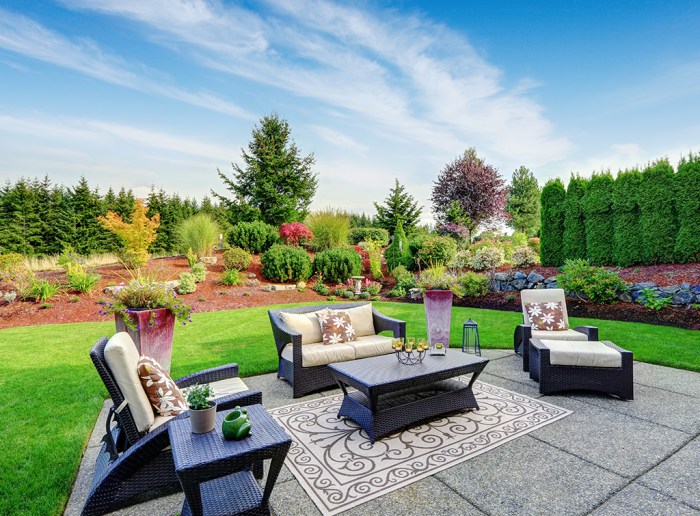
Source: checkatrade.com
Outdoor lighting transforms a home’s exterior, enhancing both its aesthetic appeal and security. Careful planning, considering energy efficiency and safety, is crucial for creating a welcoming and functional outdoor space. The right lighting scheme can highlight architectural features, illuminate pathways, and deter potential intruders, all while contributing to the overall ambiance of your property.Effective outdoor lighting design balances functionality and aesthetics.
It’s not just about illuminating the space; it’s about creating layers of light that accentuate specific features and create a mood. This involves choosing the appropriate fixtures for different areas and considering the overall style of your home.
Outdoor Lighting Schemes
Three distinct lighting schemes can be implemented to achieve different effects. Each utilizes a combination of pathway lights, spotlights, and string lights, strategically placed to maximize impact.
- Scheme 1: Warm and Welcoming. This scheme focuses on creating a warm, inviting atmosphere. Pathway lights with warm-white LED bulbs line walkways and steps, providing safe and gentle illumination. Spotlights are used to highlight architectural details like entryways or unique landscaping features. String lights are draped across trees or along fences, adding a touch of whimsy and charm.
Imagine a charming cottage-style home with a winding pathway leading to the front door. Pathway lights guide guests safely, while spotlights subtly illuminate the stonework around the entryway. String lights, softly glowing in the trees, complete the scene, creating a cozy and inviting ambiance.
- Scheme 2: Modern and Minimalist. This scheme prioritizes clean lines and subtle illumination. Recessed pathway lights are used to subtly illuminate walkways, avoiding visual clutter. Sleek, minimalist spotlights are strategically placed to highlight key architectural features, such as the house’s facade or a modern water feature. String lights are omitted to maintain a clean, uncluttered look.
Picture a contemporary home with sharp angles and a minimalist landscape. Recessed pathway lights create a safe and unobtrusive pathway, while strategically placed spotlights accentuate the home’s geometric lines and the clean lines of the landscaping. The overall effect is sophisticated and understated.
- Scheme 3: Dramatic and Accentuated. This scheme uses lighting to create a dramatic and visually striking effect. Uplighting is used to highlight trees or other tall landscaping features, creating a sense of height and grandeur. Spotlights with adjustable beams are used to dramatically highlight architectural details or sculptures. String lights are used sparingly, perhaps to Artikel a pergola or other focal point.
Creating a welcoming home exterior begins with thoughtful landscaping; consider the overall aesthetic you’re aiming for. Once the outside is perfect, you can turn your attention inwards, perhaps selecting a new dining area with a beautiful set from Stylish dining room sets to complement your home’s improved curb appeal. Finally, remember that cohesive interior and exterior design enhances the overall impact of your home’s landscape.
Consider a large Victorian home with elaborate architectural details. Uplighting illuminates tall trees framing the house, while spotlights highlight the intricate details of the facade. String lights subtly Artikel a gazebo in the backyard, adding a touch of elegance to the overall dramatic effect.
Energy Efficiency and Safety Considerations
Energy-efficient lighting is crucial for both environmental responsibility and cost savings. LED lighting is highly recommended for its long lifespan, low energy consumption, and bright output. Safety is paramount. Fixtures should be installed correctly to prevent hazards, and pathways should be well-lit to prevent trips and falls. Motion sensors can be incorporated to automatically turn lights on and off, conserving energy and enhancing security.
Low-voltage lighting systems are safer than high-voltage systems, minimizing the risk of electric shock. Regular maintenance, including cleaning and replacing damaged bulbs, is also essential for safety and optimal performance.
Aesthetic Appeal and Security Enhancement
Outdoor lighting significantly enhances a home’s curb appeal by highlighting its best features and creating a welcoming atmosphere. Well-lit walkways and entrances improve visibility and safety, deterring potential intruders. Strategic placement of lights can draw attention away from vulnerable areas, while motion-sensor lights can startle potential trespassers. The combination of aesthetic enhancement and improved security makes outdoor lighting a valuable investment for any homeowner.
For example, a well-lit front porch creates a welcoming atmosphere and makes it easier for visitors to find the doorbell, while motion-sensor lights around the perimeter of the house deter intruders and provide a sense of security.
Revitalizing your home’s exterior involves careful consideration of various elements, from plant choices to hardscaping. Adding unique, handcrafted accents can elevate the overall design; consider incorporating beautiful, bespoke planters crafted from materials like clay, sourced from artisans like those at Handmade ceramics. These pieces add a touch of personality and artistry, complementing the carefully chosen landscaping to create a truly memorable outdoor space.
The result is a cohesive and visually stunning home exterior.
Backyard Oasis Creation: Home Exterior Landscaping Ideas
Transforming your backyard into a personal oasis involves careful planning and design to create a relaxing and private retreat. This section explores the key elements needed to achieve this, focusing on the integration of functional spaces with aesthetically pleasing landscaping. We’ll cover patio/deck design, seating arrangements, water features, and the use of various materials to achieve a cohesive and inviting outdoor space.
A well-designed backyard oasis balances functionality with aesthetics. It should be a space where you can unwind, entertain guests, and enjoy the beauty of your surroundings. The key is to thoughtfully consider each element, ensuring they complement each other and contribute to the overall atmosphere of tranquility and privacy.
Patio or Deck Area Design and Placement
The patio or deck forms the central hub of your backyard oasis. Consider its size and placement relative to the sun’s path and existing structures. A south-facing deck will maximize sunlight exposure, ideal for warmer climates. Conversely, a north-facing patio might be preferable in hotter regions. Material selection plays a crucial role in both aesthetics and durability.
Wood offers a natural warmth, while concrete provides durability and versatility. Stone patios create a sophisticated and timeless look. The choice depends on personal preference, budget, and the overall design style of your home. For example, a large, multi-level deck made from pressure-treated wood might be suitable for a family with children, offering ample space for activities.
Home exterior landscaping ideas often focus on creating curb appeal, and a key element of that is incorporating seasonal color. To achieve a vibrant spring look, consider adding pops of color with flowering plants and shrubs. For inspiration on bringing that same springtime vibrancy indoors, check out these beautiful Spring floral arrangements for homes which can complement your exterior design choices.
Ultimately, a cohesive design approach, both inside and out, enhances the overall aesthetic of your property.
A smaller, more intimate stone patio might be ideal for a couple looking for a quiet retreat.
Seating Arrangement and Ambiance
The seating arrangement should encourage relaxation and conversation. Consider incorporating a variety of seating options to cater to different needs and preferences. This might include comfortable outdoor sofas, armchairs, and even a hammock for lounging. Strategic placement of lighting, such as string lights or lanterns, can create a warm and inviting atmosphere in the evenings. The addition of outdoor cushions and throws adds to the comfort and style.
For example, a grouping of wicker chairs around a fire pit offers a cozy setting for evening gatherings. A hammock suspended between two trees provides a secluded spot for reading or relaxation.
Water Feature Integration
A water feature adds a soothing element to any backyard oasis. A small pond with aquatic plants offers a natural and tranquil feel, while a fountain provides a more dynamic visual and auditory experience. The size and style of the water feature should be proportional to the overall space. For instance, a large pond might be overwhelming in a small backyard, while a small fountain might be lost in a very expansive one.
The choice of materials for the water feature should also complement the overall design scheme. Natural stone can create a rustic look, while concrete offers a more modern aesthetic.
Creating a Relaxing and Private Space
Privacy and relaxation are paramount in a backyard oasis. Strategic planting of trees and shrubs can create natural screens, blocking unwanted views and creating secluded areas. Consider using tall, evergreen trees to provide year-round screening. Deciduous trees offer shade in the summer and allow sunlight in the winter. Pergolas and trellises adorned with climbing plants can add both privacy and visual interest.
Outdoor fabrics, such as curtains or screens, can also provide temporary privacy. For example, bamboo screens offer a natural and aesthetically pleasing way to create privacy, while a pergola draped with flowering vines adds both beauty and shade.
Material Selection for Outdoor Structures and Features
The choice of materials significantly impacts the longevity, aesthetic appeal, and overall feel of your backyard oasis. Wood, stone, and concrete are popular choices, each offering unique advantages and disadvantages. Wood provides warmth and a natural look but requires regular maintenance. Stone offers durability and a timeless aesthetic but can be more expensive. Concrete is versatile, durable, and relatively affordable, but it can lack the warmth of wood or stone.
The selection should be guided by your budget, maintenance preferences, and desired aesthetic. For example, a composite decking material offers the look of wood with increased durability and lower maintenance requirements.
Closure
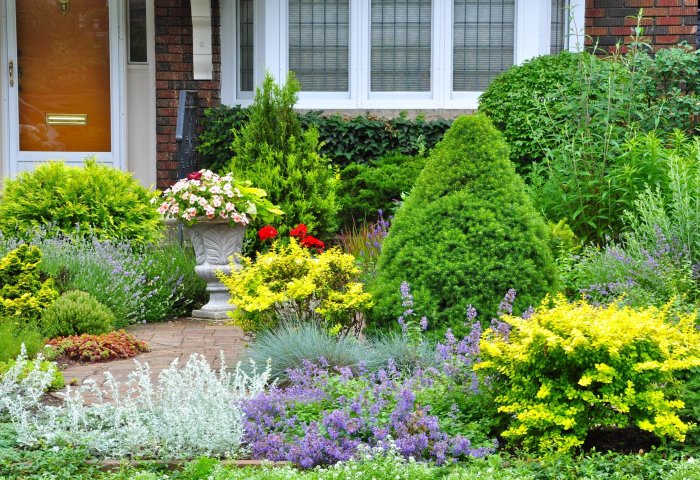
Source: birdsandblooms.com
Ultimately, transforming your home’s exterior through thoughtful landscaping involves a blend of creativity, practicality, and a deep understanding of your home’s architectural style and surrounding environment. By carefully considering factors such as budget, sustainability, and the desired aesthetic, you can create an outdoor space that enhances your property’s value, reflects your personal style, and provides a welcoming and enjoyable environment for years to come.
Remember to prioritize planning, research suitable plants and materials for your climate, and don’t hesitate to seek professional advice when needed. The journey of creating your dream landscape is a rewarding one, filled with the potential to significantly improve the beauty and functionality of your home.
FAQ Insights
What are some common mistakes to avoid when landscaping?
Common mistakes include neglecting proper soil preparation, over-planting, ignoring drainage issues, and failing to consider the mature size of plants. Insufficient planning and a lack of understanding of your local climate can also lead to problems.
How often should I water my newly planted landscaping?
Frequent, deep watering is crucial for the first few months after planting to establish a strong root system. The frequency will depend on your climate and soil type, but aim for consistent moisture without overwatering.
How do I choose the right plants for my climate?
Consult your local nursery or gardening center for plants that thrive in your specific hardiness zone. Consider factors like sunlight exposure, soil type, and water availability when making your selections.
What is the best time of year to landscape?
The ideal time varies by climate, but generally, spring and fall offer the most favorable conditions for planting. Avoid extreme heat or cold.
How can I maintain my landscaping over the long term?
Regular weeding, pruning, fertilization, and watering are essential. Mulching helps retain moisture and suppress weeds. Consider professional maintenance for larger or more complex landscapes.


